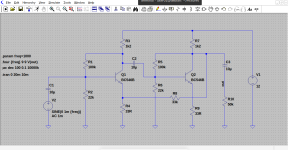I am attaching a simple preamp using two NPN transistors. The gain is 350 times and the distortion is just under 0.1%. Since the no signal voltage at the collectors depends on the supply voltage, it is in fact approximately Vcc/2, this preamp requires a very clean power supply that is regulated.
The preamp tries to linearise the base emitter characteristic by using a resistor in parallel with the base-emitter junction. It achieves local negative feedback using a resistor connected between the base and collector. The preamp also uses global negative feedback.
Since the preamp does not self oscillate and is using global negative feedback without a Miller compensating capacitance, it is interesting to investigate why.
The preamp tries to linearise the base emitter characteristic by using a resistor in parallel with the base-emitter junction. It achieves local negative feedback using a resistor connected between the base and collector. The preamp also uses global negative feedback.
Since the preamp does not self oscillate and is using global negative feedback without a Miller compensating capacitance, it is interesting to investigate why.
Attachments
Well the loop gain must be small, otherwise the measured gain would be around 1000. So the Nyquist criterion for oscillation is avoided. Try changing R8 to 3k3 - the gain should be close to 100 and stability might become an issue with the higher loop gain (which pushes the unity-gain frequency higher where more poles lurk).
